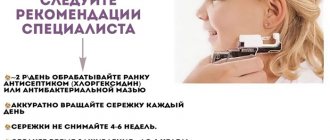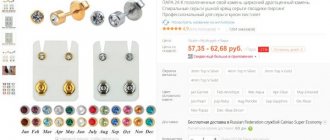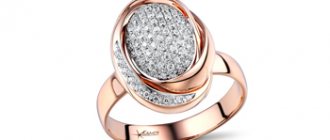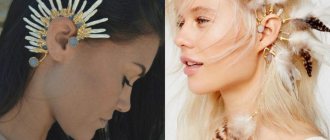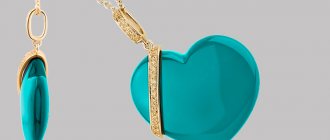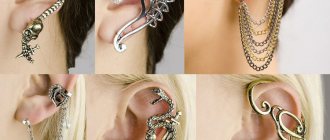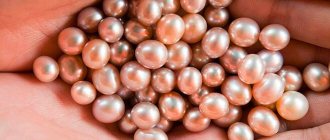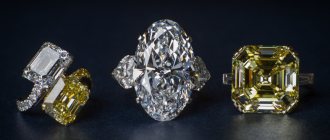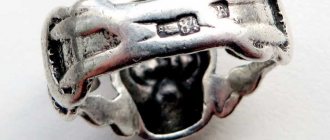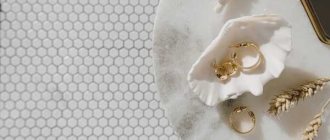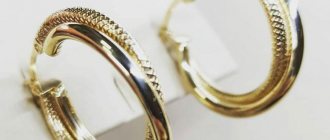Ear piercing is one of the most popular procedures in the world, which has come to us since ancient times. The tradition of earlobe piercing among the tribal peoples of Africa, Asia and the Middle East has turned into an entire art that appeals not only to modern women, but also to men.
But, despite the prevalence and popularity of piercing, many still do not know how to properly prepare for the procedure and what to do after ear piercing to prevent complications. In this article we will take a detailed look at all the important questions that arise for anyone who wants to decorate their ears with beautiful accessories.
Nowadays, getting your ears pierced is not a problem. One great and painless way is to puncture with a medical gun, which will do all the work in a matter of seconds.
The products are made from hypoallergenic medical alloy. The clasp is made so that while wearing the jewelry does not cling and does not interfere with the person. One question remains: when and how to remove earrings, especially for children.
How long should you wear your first earrings?
It is recommended to wear the first medical earrings for 1-2 months. It is not recommended to remove stud earrings after a piercing or ahead of time for several reasons:
- studs fix the correct direction of the puncture, eliminating its displacement or deformation;
- If you follow the simplest rules of hygiene, infections will not get into the wound;
- painless tightening of the damaged part of the lobe occurs around the stud guide.
The indicated period is averaged and is due to a number of objective and subjective reasons.
Depending on age, gender, general health and epidermis, you can remove medical earrings from your ears earlier or later than expected. For those who make numerous piercings of the earlobe, around the perimeter or inside the auricle (Daith, Industrial, Tragus and other types of piercing), the period of wearing medical earrings can be significantly extended.
If you are sure that the healing of the standard puncture was successful, there is no pain or other unpleasant sensations, you can remove the first stud earrings yourself. In case of a complex piercing, it is better to contact a specialist.
Safety
By contacting a specialized center, qualified specialists will pierce the earlobe using a special system. This piercing method is completely safe and hygienic. Ear piercing is done by piercing, and not by shooting. The tissues of the earlobe simply move apart, unlike the shooting method, when they rupture. The sensation of pain when using this system is minimized, and there is no risk of infection. The possibility of a mistake when using this method is also excluded. Thanks to this system, you can pierce your ear at any age, as can be seen in the photo.
The earring-needle clasp is mounted in the cartridge in such a way that the earring cannot fall out of the ear. Also, the earlobe will not be pinched, which will contribute to a faster healing process.
The needle earrings have a beautiful design, so they can be used as decoration in the future.
Despite the availability of professional equipment, it is still worth getting advice from a specialist before piercing your earlobe. Sometimes there may be some contraindications. Before piercing a child's ear, you need to examine what his psychological and emotional state is.
As practice shows, in a healthy child, both physically and emotionally, the puncture passes without pain, and the healing process proceeds faster.
How to remove stud earrings correctly
If the puncture site and the protruding parts of the studs are periodically treated with a disinfectant, removing medical stud earrings from your ears will not be difficult.
- Hands are thoroughly washed with soap and treated with alcohol, a weak solution of hydrogen peroxide or any antiseptic.
- Using a cotton swab or disk moistened with any of the above products, wipe the earlobe on both sides and the protruding parts of the stud.
- The earring is carefully turned in one direction and the earlobe and stud are wiped again with an antiseptic.
- The latch/lock is unfastened or removed.
- Slowly, with twisting if necessary, the earring is removed from the ear.
- Again, the earlobe is treated with an antiseptic on both sides, including the puncture site.
If the wound has healed completely and there are no painful or other unpleasant sensations, you can put on new earrings. In case of burning, tingling at the puncture site, or presence of bloody or other discharge, you should consult a doctor to rule out possible inflammation.
Do not try to suddenly remove stud earrings after piercing your ears with a gun. In addition to pain, it can damage the epidermis and cause bleeding or inflammation.
How to unfasten a stud earring
Knowing the type of clasp, opening stud earrings is quite simple:
- the metal threaded fastener is carefully unscrewed;
- the silicone retainer is smoothly removed from the stud guide;
- Unlocking the classic lock allows you to easily unfasten the stud earring after piercing.
When choosing medical earrings, pay attention not only to comfort during use, but also to the type of fixation. The lock is the most popular and comfortable type of fastener. It fixes the earrings at a certain level and is easy to unfasten.
Earrings with English lock
English lock earrings are the most common type of earrings. The English castle is popular among jewelers due to its reliability. You will not lose earrings with such a lock if you carelessly snag the earring.
What does it look like
The earpiece is located in a hole in the earlobe and is connected to the hole in the earring using a small spring mechanism. When you put on the earring, you hear a slight click, which means that the clasp mechanism is working correctly and you have fastened the earrings securely.
How to remove
Despite the fact that the English lock is very reliable, its mechanism is quite fragile. It is recommended to remove earrings with an English lock at night to avoid damaging the clasp.
The procedure for removing earrings with an English lock:
- Be sure to carry out hygiene procedures to disinfect your hands and new earrings.
- Unfasten earrings with an English lock slowly, without applying additional physical effort. Hold the earring with your left hand. Place your index finger at the top of the bow. Place the thumb of your right hand on the protruding part of the arch and move it towards the index finger.
- You will hear a click, which means everything is done correctly and the earring is unfastened.
- Before putting on new earrings, disinfect the hole in your earlobe.
As with a stud earring, a new English lock can be difficult to open. But once the lock is developed, you will be able to remove your earrings with ease.
How to remove earrings for a child after being pierced with a gun
Medical stud earrings for children are removed in the same way as for adults. It is important to initially choose lighter and more comfortable models of studs with a convenient, easily removable clasp. Since the baby may touch his ears when feeling discomfort, it is necessary to choose a durable and securely blocking clasp.
If, after the required period of time after the puncture, the wound has healed, no discharge or inflammation is noticed, the mother can remove the child’s medical stud earrings on her own. In other cases, it is better to contact a specialist.
What not to do
You cannot remove medical studs until the holes have fully healed and the canal has formed. You should make sure that the tissue of the lobe around the puncture is not swollen, since in this case the extraction process will be difficult, even if the hole has completely healed. Also, after complete healing and removal of the first studs, it is not advisable to immediately put on earrings - it is better to give your ears an hour’s rest and only then put on the next piece of jewelry.
When the stud does not yield to effort, you do not need to remove it yourself - you need to contact specialists who will perform the manipulation as painlessly as possible and without unnecessary trauma to the lobe.
For reference! Sometimes the clasp of medical nails is too tight and the use of specialized wire cutters may be required.
Tips for choosing a new decoration
There is a misconception: when medical earrings are removed, you can put on any jewelry.
The main purpose of wearing studs is to heal the wound and correctly fix the direction of the puncture. After 1-2 months, the formed layer of epidermis is thin, and the circulatory system and earlobe tissues have not yet been sufficiently restored.
Therefore, the choice of new jewelry must comply with the following rules:
- earrings should be light and comfortable, not deform the earlobe and not interfere with blood circulation;
- products are made of precious metals (gold, platinum, silver);
- You should not use a new model of studs again, so as not to pinch the lobe;
- It is advisable to use jewelry with earrings and a lock to secure the product.
Proper care of piercings
No matter how much you would like to put on beautiful gold or silver earrings immediately after visiting the salon, the first pair will be medical studs. Difficulties may arise during the healing process, and to avoid them, we recommend following these tips:
- treat the puncture with an antiseptic three to four times a day and wash with warm water and soap
- once every two days, carefully turn the earring to rid it of dried ichor;
- do not visit the sauna in the first month after the procedure;
- Do not allow dirt or dust to get into the punctures.
The ears heal within a month, and the canals are formed in two. If during this time the earlobes have not healed and fluid comes out of the wounds, consult a doctor.
We remove medical earrings without consequences
During the procedure, the gun secures the earrings very tightly, so it is important to carefully open the clasp and not damage the puncture.
Step-by-step instructions for changing earrings:
- prepare cotton pads and antiseptic, as well as blunt-ended scissors to open the clasp
- treat the puncture site and scissors with an antiseptic and gently move the earring, do not try to remove it immediately;
- insert the ends of the scissors into the hole in the clasp and carefully open them, while pulling up the earring. If the scissors do not fit, use tweezers;
- after removing the stud, treat the ear with an antiseptic again and leave it for an hour;
- Carefully insert the previously disinfected new jewelry.
Changing jewelry prematurely can lead to inflammation. It’s better to wait until the lobes heal completely – about 2-3 months. If the ear is swollen and ichor begins to ooze from the puncture again, treat it regularly with chlorhexidine.
Rubbing alcohol or other alcohol-containing substances should not be used as they may burn the skin and worsen the piercings.
How to choose earrings instead of medical studs?
Tips for choosing jewelry for fresh piercings:
- Do not wear jewelry in the first six months after the procedure - due to oxidation, the ear will most likely become inflamed.
- It is better to buy gold earrings - the metal is ideal for newly healed ears because, unlike silver, it does not oxidize.
- Do not choose earrings that are too thin - in the first months the punctures will heal quickly, and in the future it will be difficult for you to wear other jewelry.
- Pay attention to the fasteners - they should not be too tight, but also tight enough.
- For kids, it is better to choose children's gold earrings - they are suitable for small ears and weigh a little.
- Don't wear long earrings with silver chains. They get tangled in the hair and fresh piercings can be easily injured by carelessly pulling on the jewelry.
If you have difficulty removing basic earrings or putting in new ones, contact a specialist at the salon for help.
Source
What to do if difficulties arise?
It may happen that the decoration fits very tightly and does not lend itself to any influence. In this case, it is better to stop any attempts to do this at home and contact any salon for professional help. It is not only people with ear piercings who experience difficulty in removing earrings; it is also quite difficult to remove jewelry from other parts of the body.
For example, for navel piercing, barbells are used, which, despite the fact that they are secured manually by the master, are much more difficult and painful to remove. The clasp of such jewelry is in the form of a ball, which is difficult to grasp due to the fact that it will slip; in such cases, it is also better to seek help from a specialist.
- The healing time for the hole is different for everyone, but with proper care and compliance with all precautions, it is about three weeks.
- Professionals recommend doing piercing with a special machine only in the earlobe. In other places, such as ear cartilage, navel, wings of the nose and lips, it is strictly not recommended. The punctured part may become deformed and healing may take longer.
- After performing such a minor operation as piercing the ears or other parts of the body, it is not recommended to take a very hot bath or visit the sauna and swimming pool for the first time. By steaming the puncture site, the healing process will be long and painful.
- Clean sea water is beneficial for the healing of punctures.
- You should not agree to piercing while your body is recovering from surgery or illness.
- During a session in the salon, the visitor can always request anesthesia.
- There is an opinion that in the earlobe there are more than a hundred active points responsible for hearing, vision and the functioning of internal organs. And if you make an unsuccessful puncture and get into any of them, the functioning of any of these senses may be disrupted. It's just a myth. Of course, these zones really exist, but not in the lobe area.
Using a needle, a special device later appeared, which quickly gained popularity. Today, almost everyone who wants to decorate their ears with earrings makes holes using this very “gun”. How to remove stud earrings after a piercing?
General rules for removing earrings after piercing
- Before starting, you need to wash your hands thoroughly (preferably with antibacterial soap);
- no need to hurry;
- processing is carried out before and after and removal;
- the use of tweezers allows you to reduce the contact of the puncture and earring with the hands, but if the hand trembles and the tweezers move crookedly, a wound with uneven edges will appear;
- You need to insert a clean, disinfected earring.
The best way to avoid difficulties with removing your first stud earring is to take the healing process responsibly . To ensure a smooth removal procedure, follow the instructions for caring for your ear and earring. Use recommended disinfectants and wound healing agents, treat regularly and do not ignore unhealthy symptoms.
Important! In case of heavy discharge, acute pain and high temperature, you should consult a doctor, and not increase the dosage of antiseptics and take painkillers. Perhaps there is a process of rejection of the earrings or the material from which they are made.
In addition to surface treatment, more thorough treatment is also used. If the healing dynamics are positive, after about 15 days from the moment of piercing, the studs will need to be removed, thoroughly wipe them and the earlobe with a disinfectant, and then reinsert . It is theirs, and not another decoration. New earrings are used only after the end of the recovery period, which on average takes 3–8 weeks.
What earrings can I wear later?
Much depends on how many weeks have passed since the piercing and how the healing period proceeded . If the tissues quickly recovered, the wound did not get wet or bleed profusely, and the swelling subsided at the time specified by the master, then by the time the earring-stud is removed, the walls of the hole will be lined with more or less durable skin. It will withstand inserting jewelry of a different design than studs.
Important! The use of a fastener of a different design is acceptable, but you cannot use jewelry with a pin of a larger diameter.
If the recovery period proceeded with complications, then you need to choose a product with a straight, short and non-curved pin, which ends with the simplest possible clasp .
The new jewelry should also be made of the same material as the old one - this way the ear will get used to it faster, and the process of rejection is unlikely to start. And don't forget to pay attention to the sample. This is important, since the sample is an indicator of the presence of impurities. If there are more of them in the second decoration than in the first, then this can cause unpleasant symptoms. Another important criterion is pin diameter . The formed channel has the size that was given to it by the gun and the subsequent wearing of studs. Therefore, you should not put on earrings whose pin is much wider than the frame of the jewelry used during the healing of the puncture wound. This will lead to the expansion of the hole by further traumatizing old and barely formed new cells.
How to care for it afterwards?
After treating the canal with hydrogen peroxide, walk around without earrings for a couple of hours, let the earlobes rest and the piercing get enough air. This is very useful for forming the correct outlines. Before inserting new earrings, treat them with peroxide or alcohol.
After medical fusion you need to wear gold jewelry . This metal itself has a slight healing effect and is hypoallergenic. Gold will help heal the ears if problems arise in the future. Silver products also have many useful properties, but sometimes minor irritations and allergic reactions occur when wearing them.
The thickness of the earrings should be approximately equal to accessories made of surgical steel . For now, you can’t wear either thin or thick arches. Also avoid jewelry with English clasps. This can be done only after six months of constant wearing of gold jewelry, which is placed in the ears instead of medical jewelry.
For this period, choose earrings that will be easy to put on and take off, and the lock will be secure, but without excessive squeezing the earlobe . If, however, the decoration fits too tightly, then you need to replace it with another one.
Important! If you experience any discomfort while wearing other earrings, return to surgical alloy accessories during the healing period.
Step by step guide on how to remove stud earrings
You need to start with a careful examination of the ear. There should be no signs of inflammation on the shell and earring: redness, swelling, discharge .
Additionally, you should make sure that touching the jewelry and adjacent tissues does not cause pain. Next we decide on the tool. If you are confident that at a crucial moment your hand will not tremble and will be able to carefully remove the stud earring with the help of an additional device, then it is worth using tweezers in the procedure. Requirements for it:
- the sides are symmetrical to each other;
- no sharp edges, only rounded ones (ideally, you should use medical tweezers, the tips of which are curved and imitate a rounded shape);
- no signs of rust, plaque, dirt;
- the metal from which the tweezers are made has hypoallergenic properties;
- The handle is comfortable and does not slip in the palm;
- Before starting the manipulation, the instrument is carefully treated with a disinfectant composition.
What to do if problems arise?
Further actions after removal depend on how the procedure went.
If everything is fine with your ear after removing the studs, then you should wait 1–2 hours. After this time, you can insert a new earring (don't forget to treat it before inserting it). If unpleasant symptoms appear - severe or increasing pain in the puncture area, bloody or purulent discharge, swelling - you will have to put on old jewelry . Most likely, the healing process has not yet been completed, hence the unpleasant manifestations. You need to give your ear more time.
Important! It is impossible to leave an unhealed puncture without an earring for a long time. This can lead to the hole becoming overgrown. In the future, an attempt to insert the jewelry into the ear will result in serious injury to the canal.
If the problem is caused not by the condition of the ear, but by the immobility of the stud from which the plug was removed, then you need to proceed as follows:
- Try to soak the formations on the hidden part of the earring. Discharge from the wound accumulates, hardens and turns into strong enough clots that do not allow the jewelry to move from its place. To get rid of them, soak a cotton pad in alcohol or hydrogen peroxide and repeatedly apply its clean part to the entrance area of the puncture channel. Important! You can soak the formations in the bath, but this method is less hygienic and reliable.
- Call another person for help. He will examine the ear and the earring he is wearing from the outside and will be able to see what is inaccessible to the wearer of the jewelry.
- If the problem is caused by a strong curvature of the back of the stud pin, then you need to take small pliers - used when working with wire - and use them to bite off the head of the decoration. It is better to sacrifice the earring than to try to remove the curved frame from a barely healed puncture and risk your own health.
These methods are used only if there is confidence that the healing process has been completed and in the absence of visible signs of suppuration . If not a single measure helps, then you need to stop tormenting the auricle and contact the master who did the piercing. Under no circumstances should you forcefully tear out an earring from your ear. Is it dangerous.
How to properly unfasten the latch
Fastening and unfastening an English lock is not as difficult as it seems at first glance. It is very easy to fasten: just get the pin into the hole. A slight click will be heard. He indicates that the mechanism has closed.
To properly unfasten the English lock, do the following:
- Hold the wire with two fingers.
- Using the thumb of your free hand, pry the pin, pushing it upward.
- The lock will open. You will feel that the earring has become loose in the lobe. This will cause the pin to rise up.
Important! Do not use too much force when opening. You can deform the lock. After all, gold and silver are ductile and soft metals.
- You must open the lock carefully. At the first click, stop pulling the pin up.
- Remove jewelry with an English lock before going to bed or playing sports. The clasp can prick your neck when bending over or sleeping. You can also accidentally catch your jewelry with your hands and break it.
- Practice fastening and unfastening earrings before wearing jewelry. This is necessary if this is your first time encountering an English castle.
Buy jewelry from trusted stores. And the English castle will serve you for many years in a row.
Today, women and girls strive to look good. They carefully select their clothes and decorate their bodies, in particular, piercing their ears. Earrings really make a woman look beautiful. That's why many mothers pierce their daughters' ears at a very young age. However, pierced ears can bring some problems to their owner. For example, an earring will not want to leave your ear. How to act in such a situation? How to remove an earring?
First of all, you should steam your ear thoroughly. To do this, you need to lie in the bathroom or take a shower. Although you can soak your ear with oil, such as camphor. This is done in order to soften the ichor that has formed in the ear. Then, you need to carefully twist the earring in your ear. After this procedure, the earring should be easily removed. In order to remove an earring from a little girl’s ear, you should take the moment while she is sleeping. After the earring is removed, the ear should be treated with an antiseptic, such as Miramistin or Chlorhexidine, and the ears should be dried a little before putting the earrings back on.
How to remove earrings without pain is now clear. But what to do if you want to decorate yourself with original earrings? How to make earrings from beads? After all, beaded jewelry is very original. In addition, they require minimal costs. But before you start weaving earrings from beads, you need to decide in advance on the pattern, shape, size and color of the beads. In addition to the beads themselves, you will need a strong thread or fishing line, earrings, and a needle. You may need other tools and parts, but this depends on the type of earrings.
Often women are faced with the fact that they cannot wear earrings. This happens when a woman wears the same earrings for a long time. Or if she recently got her ears pierced. So how to wear earrings? Probably the simplest method is to ask someone for help. But what if there is no such “helper” nearby? Then try putting the earring on backwards. That is, put the front side of the earring on the back side of the ear. And then try again to put the earring on as it should be. This usually helps. If it doesn’t help, you should put on your old earrings and try to move and twist them every day so that the hole from the puncture becomes a little larger. After this you will be able to wear other earrings.
To highlight their individual style, many modern girls strive to make jewelry with their own hands. How to make earrings with your own hands? Here is one of the simplest options. For it you will need: fishing line, two earrings, beads of the same color and size, 4 huggers (for beads), two beads (of the same color as the beads). Fix two strands of fishing line of equal length on the hooks. Each earring will have two “tails”. You need to put seven beads on each “tail”, after which you need to pass both threads through the hook and fasten to form a bow. Place a hugger, a bead, another hugger and 10 beads on both ends of the fishing line. Then, thread the fishing line through the bead and fix it on the hook. Do the same with the second shvenza. The earrings are ready.
Thus, it has now become clear what to do when the earring cannot be removed and, on the contrary, cannot be put on. It is also known that earrings can be purchased not only in the store.
An English castle is among the most popular options. That is why it is very important to learn how to handle it correctly. Having practiced on 1 piece of jewelry, you will be able to quickly and accurately unbutton and fasten all products with a similar principle of fixation.
Features of removing medical stud earrings from a child
You can’t explain to your baby why you should never move during a relatively painful procedure. To prevent his restless fidgeting from leading to new damage to the earlobe, do the following (choose 1 of the suggested options):
- Contact the salon and ask to remove the earring. If the child is very sensitive, it makes sense to resort to painkillers. Its application will not cause harm, since it does not have the form of injections or tablets, but comes in the form of a spray.
- Carry out the manipulation yourself, choosing the right moment. Ideal option: the child is fast asleep and does not react to touching himself.
- Before removing, be sure to make sure that there are no visible signs of suppuration. Manipulating an unhealed wound will definitely wake up the baby.
Source
